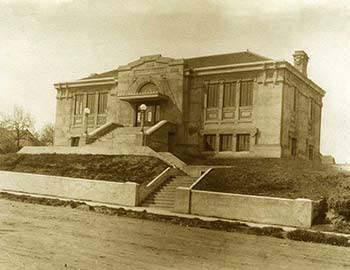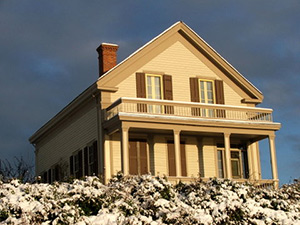Background
In 1851, the S’Klallam People who had been living at qatáy (kah-tai) since time immemorial, were met by the arrival of a small number of people of European descent, and later, a diverse population of immigrants. The newcomers saw opportunity and stayed, built cabins, and called qatáy Port Townsend. The settlers were aided by the S’Klallam chief čičməhán in 1857 when hostile natives threatened to attack. Although čičməhán would later be revered by the settlers for his dedication and help, this did not prevent the S’Klallams from being removed from qatáy by force from in 1858. Even though they were removed, many of the S’Klallams returned to the place that was their home. In 1871, by Federal Order, the Indian Agents assigned to the North Olympic Peninsula burned the village of qatáy.
 The settlers had big dreams, including a railroad that would connect Port Townsend to San Francisco. Port Townsend would be the “New York of the West.” By the 1880s, a city with a busy waterfront comprised of stone and brick buildings was being rapidly built, along with elegant Victorian homes up on the bluff that would house these entrepreneurs. Port Townsend was an international port with ships from all over the world docking there. Immigrant entrepreneurs from China, estimated at 453 people, made up 9% of the population.
The settlers had big dreams, including a railroad that would connect Port Townsend to San Francisco. Port Townsend would be the “New York of the West.” By the 1880s, a city with a busy waterfront comprised of stone and brick buildings was being rapidly built, along with elegant Victorian homes up on the bluff that would house these entrepreneurs. Port Townsend was an international port with ships from all over the world docking there. Immigrant entrepreneurs from China, estimated at 453 people, made up 9% of the population.
Establishment of JCHS
Some Port Townsend residents felt a historical society should be established to record the accomplishments of the area’s settler citizens. On May 3, 1879, the Jefferson County Historical Society (JCHS) of Washington Territory was founded. Just a few years later, Port Townsend’s fortunes began to decline.  The railroad bypassed the Olympic Peninsula, there was an international economic crash, and Port Townsend Bay lost the advantage of its good winds when steam replaced sail. The town’s population sharply declined between 1893 and 1915, and the Historical Society dwindled into inactivity.
The railroad bypassed the Olympic Peninsula, there was an international economic crash, and Port Townsend Bay lost the advantage of its good winds when steam replaced sail. The town’s population sharply declined between 1893 and 1915, and the Historical Society dwindled into inactivity.
In 1932, James J. McCurdy and Frank Hastings reactivated JCHS with the purpose to collect and preserve “papers, documents, photographs, pictures, and other objects.” Space was secured in the basement of the Carnegie Library to house the collections and conduct society business.
Current History Once again JCHS became inactive but was revived in 1947 with the establishment of a constitution and by-laws. JCHS conducted a campaign to repair and repaint the old bell tower which created an awareness of the Historical Society. The city gave JCHS permission to use to the old police courtroom for a museum, which opened in 1951 for Port Townsend’s centennial
celebration. This time JCHS had enough momentum to continue to grow. In 1960 a research library was established and in 1966 With Pride in Heritage was published, JCHS’s first major publication.
Once again JCHS became inactive but was revived in 1947 with the establishment of a constitution and by-laws. JCHS conducted a campaign to repair and repaint the old bell tower which created an awareness of the Historical Society. The city gave JCHS permission to use to the old police courtroom for a museum, which opened in 1951 for Port Townsend’s centennial
celebration. This time JCHS had enough momentum to continue to grow. In 1960 a research library was established and in 1966 With Pride in Heritage was published, JCHS’s first major publication.
By 1971, the Bell Tower was again in need of repair. JCHS raised over $9,500 to pay for the effort and in gratitude the City gave the group a 99-year lease in part of the Historic City Hall for a museum and archive.
Port Townsend’s abundance of beautiful Victorian buildings was beginning to attract attention as they were being restored by dedicated owners. In 1975, the Washington Trust for Historic Preservation was established, and its headquarters operated out of the Jefferson County Historical Society before moving to Olympia.
 JCHS manages two historic house museums, the Rothschild House and the Commanding Officers Quarters, in partnership with the Washington State Parks and Recreation Commission. In addition to these houses, JCHS is responsible for the preservation of a continually growing collection of artifacts, photographs, and documents and manages the Olympic Peninsula Gateway Visitor Center, the Jefferson County Research Center, and the Jefferson Museum of Art & History in Historic City Hall. Since 1978, JCHS has been recognizing preservation and restoration projects with the annual Mary P. Johnson awards.
JCHS manages two historic house museums, the Rothschild House and the Commanding Officers Quarters, in partnership with the Washington State Parks and Recreation Commission. In addition to these houses, JCHS is responsible for the preservation of a continually growing collection of artifacts, photographs, and documents and manages the Olympic Peninsula Gateway Visitor Center, the Jefferson County Research Center, and the Jefferson Museum of Art & History in Historic City Hall. Since 1978, JCHS has been recognizing preservation and restoration projects with the annual Mary P. Johnson awards.
At the beginning of yet another century, JCHS had its own restoration projects for which it needed to raise money. The Bell Tower needed attention again and the Historic City Hall, built in 1892, was over 100 years old in 2004 and showing its age and hard life in the marine environment (the third story had already been removed in the 1940s due to damage from a storm). The City needed more space and built an annex behind the Historic City Hall building which then underwent a major restoration, funded by JCHS supporters and the City. The result was beautiful and JCHS moved back into their renewed headquarters in 2006.
There was still more to do. JCHS had outgrown the storage space provided in Historic City Hall, and some were being stored at Fort Worden in less than ideal conditions. In 2003, the Research Library moved out of City Hall into an old church building purchased by JCHS on highway 19. Safe storage space was still needed for all the artifacts in JCHS’s care. After years of grant writing and soliciting private donations, work was started in 2011 on a new state-of-the-art Collections Building next to the Research Library. In 2012, the archives and documents were moved to their new home in the Collections Building. Unfortunately, shortly after the Collections Building was completed, major flaws in its building envelope and HVAC systems were found.
 That same year, 2012, it was decided that a name change was needed for the Jefferson Museum of History. For the past fifty years, Port Townsend had become increasingly
associated with the arts and it was time to reflect this in the museum’s new name – the Jefferson Museum of Art & History. Nora Porter helped facilitate this expansion of focus when she donated her fine collection of area artists to JCHS. Other collectors and artists followed her lead and helped to establish the museum’s art collection.
That same year, 2012, it was decided that a name change was needed for the Jefferson Museum of History. For the past fifty years, Port Townsend had become increasingly
associated with the arts and it was time to reflect this in the museum’s new name – the Jefferson Museum of Art & History. Nora Porter helped facilitate this expansion of focus when she donated her fine collection of area artists to JCHS. Other collectors and artists followed her lead and helped to establish the museum’s art collection.
Problems continued in the Collections Building; after many years of meetings, discussions, and planning, a major renovation project was underway in 2019. It was a difficult job made more challenging due to the having to carefully move artifacts out of the way. The Building Renovation will be complete in 2022.
JCHS has continued to grow on many levels since its beginnings. There is an increasing awareness of the wide variety of people who are part of our history and all the stories they have to tell. JCHS has many ways of telling these stories; we do this through programming, objects, books, exhibits, and tours—just to name a few. We work to enrich and preserve our history by including all the stories of people who lived here in the past and the present.